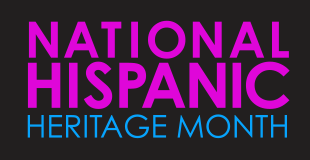Julie Kinnaird | September 15, 2021

Each year, from September 15 to October 15 we celebrate and honor the histories, diverse cultures, achievements, and many contributions of Hispanic and Latinx citizens, past and present whose ancestors came from Spain, Mexico, the Caribbean, and Central and South America. Started in 1968, under President Lyndon Johnson, the observance has grown from one week to 30-days. It was enacted into law on August 17, 1988, on the approval of Public Law 100-402. Since then, every sitting U.S. president has made a yearly National Hispanic Heritage Month proclamation. President Biden’s proclamation can be found here. The 30-day period extending from the middle of September to the middle of October was chosen because during this time seven countries observe their own Independence Day, including Costa Rica, El Salvador, Guatemala, Honduras, Nicaragua, Mexico, and Chile.
Today, over 62 million Hispanics live in the United States. According to the Pew Research Center Hispanics made up nearly one-in-five people in the U.S., or 19%, in 2020. This is up from 16% in 2010 and just 5% in 1970. All 50 states and the District of Columbia have experienced growth in their Hispanic populations since 2010.
The many valuable contributions and accomplishments of Hispanic and Latinx people date back well before 1968 and continue to impact our daily lives. President Biden’s proclamation said, “During National Hispanic Heritage Month, we recognize that Hispanic heritage is American heritage. We see it in every aspect of our national life” and noted contributions to the arts and culture, science, healthcare, military and government, education and more. According to the U.S. Bureau of Labor Statistics, the share of the nation’s total labor force has increased by 16.6 million during the 2000–16 period, with Hispanics or Latinos accounting for nearly two-thirds of the increase (10.1 million). According to the U.S. Bureau of Labor Statistics employment projections, the Hispanic labor force is expected to represent nearly one-fifth of the labor force by 2024.
This Fall, consider using this month-long celebration of Hispanic and Latinx heritage as a starting place to integrate Latin American art, culture, history, economics, geography, and the people of Latinx and Hispanic origin into your curriculum and don’t stop there! Through the official National Hispanic Heritage Month website, you can find information on events from the partners and sponsoring agencies, audio and video files, and dozens of other resources for teachers. These resources can be used all year long! Below are several other resources for helping introduce or expand your teaching and learning about the diverse and vibrant Hispanic and Latinx heritage.
Additional Resources:
Duke-UNC Consortium in Latin American and Caribbean Studies: Educational Outreach
State Library of North Carolina: North Carolina’s Hispanic Heritage, A guide celebrating the contributions Hispanics have made and continue to make to North Carolina
Smithsonian Latino Center: Hispanic Heritage Month Resources and Teaching and Learning Resources
Smithsonian Learning Lab: Top 8 Reasons Why and How We Celebrate Hispanic Heritage Month
National Endowment for the Humanities/EdSitement: Teacher’s Guide Hispanic and Latino Heritage and History in the United States
PBS: Latino Americans (documentary)
